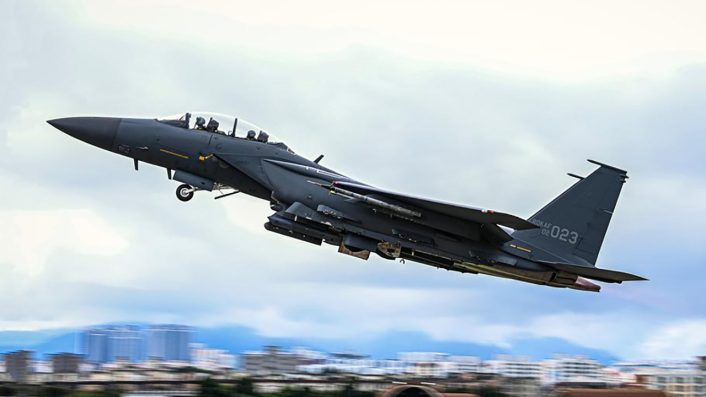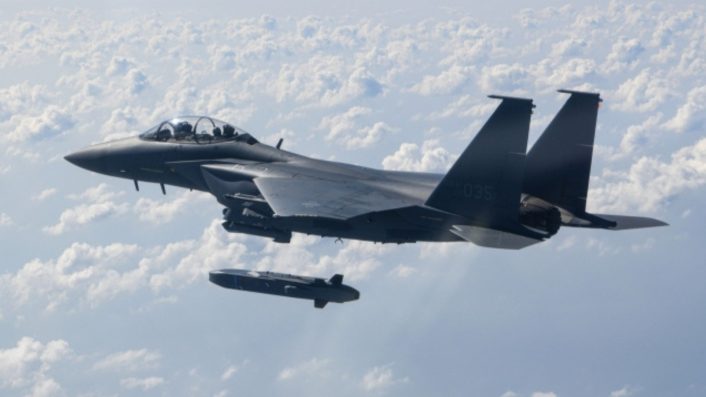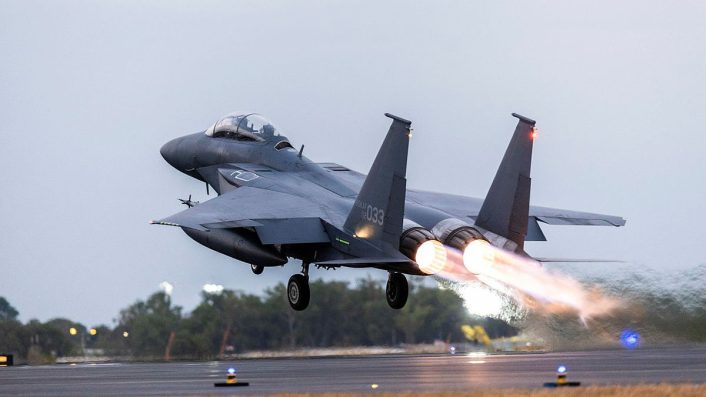The State Department has approved the possible sale of components that will allow South Korea to upgrade its F-15K Slam Eagle fleet to a configuration similar to the F-15EX Eagle II.
The U.S. State Department has approved on Nov.19, 2024, a possible Foreign Military Sale (FMS) to the Republic of Korea of components that will allow the upgrade of the country’s F-15K Slam Eagle fleet. The package, which has an estimated cost of $6.2 billion, follows the decision in 2022 to launch an upgrade program for the aircraft.
The Slam Eagles are the mainstay of the Republic of Korea Air Force’s (ROKAF) multirole missions, with a particular ‘heavy hitting’ long-range strike role. According to the available data, the country operates 59 F-15Ks out of 61 which were initially fielded in 2005. In 2022, the Defense Acquisition Program Administration (DAPA) approved the launch of an upgrade program planned to run from 2024 to 2034.
In particular, the Defense Security Cooperation Agency’s (DSCA) FMS notice says a number of components were requested for the upgrade, including 96 Advanced Display Core Processor II (ADCP II) mission system computers, 70 AN/APG-82(v)1 Active Electronically Scanned Arrays (AESA) radars, seventy 70 AN/ALQ-250 Eagle Passive Active Warning Survivability System (EPAWSS) electronic warfare (EW) suites and 70 AN/AAR-57 Common Missile Warning Systems (CMWS).
In addition to these, South Korea will also get modifications and maintenance support, aircraft components and spares, consumables, training aids and the entire support package commonly associated with FMS. It is interesting to note that the notice also includes aerial refueling support and aircraft ferry support, so it is possible that at least the initial aircraft will be ferried to the United States for the modifications before the rest are modified in country.
The components included in the possible sale will allow the ROKAF to upgrade its entire fleet of F-15Ks to a configuration similar to the new F-15EX Eagle II currently being delivered to the U.S. Air Force. Interestingly, the Korean configuration will also include the CMWS, currently not installed on the EX, so the F-15K will also require some structural modifications to add the blisters on each side of the canopy rail where the sensors are installed.
“This proposed sale will improve the Republic of Korea’s capability to meet current and future threats by increasing its critical air defence capability to deter aggression in the region and to ensure interoperability with US forces,” says the DSCA in the official notice.
The upgrade of the F-15K is part of a broader modernization of the ROKAF’s fighter fleet. In fact, the service is also upgrading its KF-16s Block 52 to the V configuration, integrating a new AESA radar, mission computer, self-protection suite, with works expected to be completed by 2025. These programs complement the acquisition of the F-35 Lightning II and the KF-21 Boramae.

The F-15K
The F-15K is a variant of the F-15E Strike Eagle built for the Republic of Korea Air Force’s (ROKAF) with almost half of the components manufactured locally. The aircraft emerged as the winner of the F-X fighter program against the Rafale, Typhoon and Su-35 in 2002, resulting in an order for 40 F-15s equipped with General Electric F110-129 engines. In 2005, a second order for 21 aircraft equipped with Pratt & Whitney F100-PW-229 engines was signed.
The Slam Eagle name is derived from the F-15K’s capability to employ the AGM-84H SLAM-ER standoff cruise missiles, with the Taurus KEPD 350K being another weapon exclusive to the ROKAF jet. The F-15K is employed as a fully multi-role aircraft and is considered ad one of the key assets of the Korean armed forces.
With the aircraft averaging an age of 16 years and expected to be in service until 2060, the Defense Acquisition Program Administration (DAPA) launched in 2022 an upgrade program for the F-15Ks. The upgrade, expected to run from 2024 to 2034, is committed to strengthening the mission capabilities and survivability of the jet.
The F-15K currently equips three squadrons at Daegu Air Base, in the southeast of the country. Although based far from the demilitarized zone (DMZ), the F-15K with its SLAM-ER and KEPD 350 missiles can still hit strategic targets deep behind North Korean borders.

The new capabilities
It is not yet clear if the F-15K will receive a new cockpit, since its configuration will be similar to the Eagle II. In fact, the F-15EX has a full glass cockpit equipped with a 10×19-inch touch-screen multifunction color display and JHMCS II both in the front and rear cockpit, Low Profile HUD in the front, stand-by display and dedicated engine, fuel and hydraulics display, in addition to the standard caution/warning lights, switches and Hands On Throttle-And-Stick (HOTAS) control.
Either way, the systems will be powered by the Advanced Display Core Processor II, reportedly the fastest mission computer ever installed on a fighter jet, and the Operational Flight Program Suite 9.1X, a customized variant of the Suite 9 used on the F-15C and F-15E, designed to ensure full interoperability of the new aircraft with the “legacy Eagles”.
The F-15K will be equipped with the new AN/APG-82(V)1 Active Electronically Scanned Array (AESA) radar. The radar, which has been developed from the APG-63(V)3 AESA radar of the F-15C and the APG-79 AESA radar of the F/A-18E/F, allows to simultaneously detect, identify and track multiple air and surface targets at longer ranges compared to mechanical radars, facilitating persistent target observation and information sharing for a better decision-making process.

The AN/ALQ-250 EPAWSS will provide full-spectrum EW capabilities, including radar warning, geolocation, situational awareness, and self-protection to the F-15. Chaff and flares capacity will be increased by 50%, with four more dispensers added in the EPAWSS fairings behind the tail fins (two for each fairing), for a total of 12 dispenser housing 360 cartridges.
EPAWSS is fully integrated with radar warning, geo-location and increased chaff and flare capability to detect and defeat surface and airborne threats in signal-dense and highly contested environments. Because of this, the system enables freedom of maneuver and deeper penetration into battlespaces protected by modern integrated air defense systems.
The AN/AAR-57 CMWS is an ultra-violet based missile warning system, part of an integrated IR countermeasures suite utilizing five sensors to display accurate threat location and dispense decoys/countermeasures. Although CMWS was initially fielded in 2005, BAE Systems continuously customized the algorithms to adapt to new threats and CMWS has now reached Generation 3.

